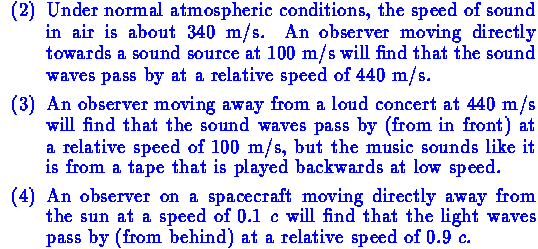


TRUE, TRUE and FALSE
Sound waves travel at a definite speed relative to the vibrating medium
(normally the air). Hence, an observer measures the speed of sound relative
to him/herself according to the "common sense" approach: combine the sound's
velocity in the air with the observer's velocity relative to the air using
the normal rules for vector addition. This approach remains valid for waves
like sound even when the observer's speed is high enough to overtake the
waves. Ignoring technical difficulties which have nothing to do with the
basic physics, an observer who is moving fast enough to overtake a sound wave
passes-by progressively earlier sounds, and hears these sounds in the reverse
of the order in which they were emitted from the source.
An EM wave does not behave in the same intuitive way, and unlike all other types of waves considered up until now, it does not need any medium in which to propagate. The observed speed of an EM wave in a vacuum is ALWAYS c = 3.00 X 108 m/s, regardless of the relative motion of the source and the observer.
